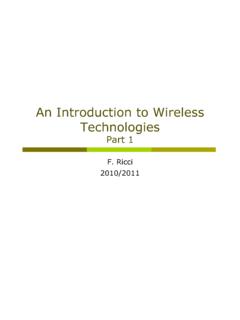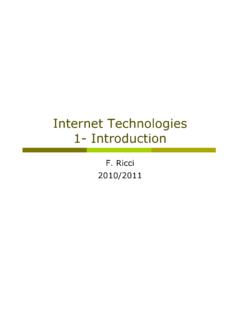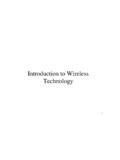Transcription of An Introduction to Wireless Technologies - unibz
1 An Introduction to Wireless Technologies Part 1 F. Ricci 2010/2011 Content Wireless communication standards Computer Networks Reference model for a network architecture Frequencies and regulations Wireless communication Technologies Signals Bandwidth limited signals Signal modulation Data transfer rate Signal propagation Most of the slides of this lecture come from prof. Jochen Schiller s didactical material for the book Mobile Communications , Addison Wesley, 2003. Analogue vs. Digital Analogue transmission of analogue data The air pressure variations (analogue data) are converted (microphone) into an electrical analog signal in which either the instantaneous voltage or current is directly proportional to the instantaneous air pressure and then transmitted ( , traditional phone or radio) Analogue transmission of digital data The electric analog signal is digitized, or converted to a digital signal, through an Analog-to-Digital converter and then modulated into analogue signals and trasmitted ( , digital phones as GSM).
2 Wireless systems: overview cellular phones satellites Wireless LAN cordless phones 1992: GSM-900 1994: GSM-1800 2001: IMT-2000 (UMTS) 1987: CT1+ 1982: Inmarsat-A 1992: Inmarsat-B Inmarsat-M 1998: Iridium 1989: CT 2 1991: DECT 199x: proprietary 1997: HYPERLAN IEEE 1999: , Bluetooth 1988: Inmarsat-C analogue digital 1991: D-AMPS 1991: CDMA 1981: NMT 450 1986: NMT 900 1980: CT0 1984: CT1 1983: AMPS 1993: PDC 4G fourth generation: when and how? 2000: GPRS 2000: IEEE 200?: Fourth Generation (Internet based) Cellular Generations First Analog, circuit-switched (AMPS, TACS) Second Digital, circuit-switched (GSM) 10 Kbps Advanced second Digital, circuit switched (HSCSD High-Speed Circuit Switched Data), Internet-enabled (WAP) 10 Kbps Digital, packet-switched, TDMA (GPRS, EDGE) 40-400 Kbps Third Digital, packet-switched, Wideband CDMA (UMTS) 2 Mbps Fourth Data rate 100 Mbps; achieves telepresence Nokia N95 Operating Frequency: WCDMA2100 (HSDPA), EGSM900, GSM850/1800/1900 MHz (EGPRS) Memory: Up to 160 MB internal dynamic memory.
3 Memory card slot - microSD memory cards (up to 2 GB) Display: " QVGA (240 x 320 pixels) TFT ambient light detector - up to 16 million colors Data Transfer: WCDMA 2100 (HSDPA) with simultaneous voice and packet data (Packet Switching max speed UL/DL= 384 , Circuit Switching max speed 64kbps) Dual Transfer Mode (DTM) support for simultaneous voice and packet data connection in GSM/EDGE networks - max speed DL/UL: kbits/s EGPRS class B, multi slot class 32, max speed DL/UL= 296 / kbits/s Services E-mail file 10 Kbyte Web Page 9 Kbyte Text File 40 Kbyte Large Report 2 Mbyte Video Clip 4 Mbyte Film with TV Quality 2G 8 sec 9 sec 33 sec 28 min 48 min 1100 hr PSTN 3 sec 3 sec 11 sec 9 min 18 min 350 hr ISDN 1 sec 1 sec 5 sec 4 min 8 min 104 hr 2G+ sec sec 3 sec 2 min 4 min 52 hr UMTS/3G sec sec 7 sec 14 sec >5hr Source.
4 UMTS Forum Computer Networks A computer network is two or more computers connected together using a telecommunication system for the purpose of communicating and sharing resources Why they are interesting? Overcome geographic limits Access remote data Separate clients and server Goal: Universal Communication (any to any) Network Type of Networks PAN: a personal area network is a computer network (CN) used for communication among computer devices (including telephones and personal digital assistants) close to one person Technologies : USB and Firewire (wired), IrDA and Bluetooth ( Wireless ) LAN: a local area network is a CN covering a small geographic area, like a home, office, or group of buildings Technologies : Ethernet (wired) or Wi-Fi ( Wireless ) MAN.
5 Metropolitan Area Networks are large CNs usually spanning a city Technologies : Ethernet (wired) or WiMAX ( Wireless ) WAN: Wide Area Network is a CN that covers a broad area, , cross metropolitan, regional, or national boundaries Examples: Internet Wireless Technologies : HSDPA, EDGE, GPRS, GSM. Reference Model Application Transport Network Data Link Physical Medium Data Link Physical Application Transport Network Data Link Physical Data Link Physical Network Network Radio Base transceiver station Base station controller Reference model Physical layer: conversion of stream of bits into signals carrier generation - frequency selection signal detection encryption Data link layer: accessing the medium multiplexing - error correction synchronization Network layer: routing packets addressing -handover between networks Transport layer.
6 Establish an end-to-end connection quality of service flow and congestion control Application layer: service location support multimedia Wireless access to www Wireless Network The difference between wired and Wireless is the physical layer and the data link layer Wired network technology is based on wires or fibers Data transmission in Wireless networks take place using electromagnetic waves which propagates through space (scattered, reflected, attenuated) Data are modulated onto carrier frequencies (amplitude, frequency) The data link layer (accessing the medium, multiplexing, error correction, synchronization) requires more complex mechanisms.
7 Waves' interference IEEE standard mobile terminal access point fixed terminal application TCP PHY MAC IP MAC PHY application TCP PHY MAC IP MAC PHY LLC infrastructure network LLC LLC Network layer Transport layer Data link layer Physical link l. CSMA/CA = Carrier Sense Multiple Access / Collision Avoidance CSMA/CA = Carrier Sense Multiple Access / Collision Detection CSMA/CD CSMA/CA Request to Send (RTS) packet sent by the sender S, and a Clear to Send (CTS) packet sent by the intended receiver R. Alerting all nodes within range of the sender, receiver or both, to not transmit for the duration of the main transmission.
8 Mobile Communication Technologies Local Wireless networks WLAN WiFi Personal Wireless nw WPAN Bluetooth ZigBee Wireless distribution networks WMAN (Broadband Wireless Access) (Mobile Broadband Wireless Access) + Mobility WiMAX Bluetooth A standard permitting Wireless connection of: Personal computers Printers Mobile phones Handsfree headsets LCD projectors Modems Wireless LAN devices Notebooks Desktop PCs PDAs Bluetooth Characteristics Operates in the GHz band - Packet switched 1 milliwatt - as opposed to 500 mW cellphone Low cost 10m to 100m range Uses Frequency Hop (FH) spread spectrum, which divides the frequency band into a number of hop channels.
9 During connection, devices hop from one channel to another 1600 times per second Data transfer rate 1-2 megabits/second (GPRS is ~50kbits/s) Supports up to 8 devices in a piconet (= two or more Bluetooth units sharing a channel). Built-in security Non line-of-sight transmission through walls and briefcases Easy integration of TCP/IP for networking. Wi-Fi Wi-Fi is a technology for WLAN based on the IEEE (a, b, g) specifications Originally developed for PC in WLAN Increasingly used for more services: Internet and VoIP phone access, gaming, .. and basic connectivity of consumer electronics such as televisions and DVD players, or digital cameras.
10 In the future Wi-Fi will be used by cars in highways in support of an Intelligent Transportation System to increase safety, gather statistics, and enable mobile commerce (IEEE ) Wi-Fi supports structured (access point) and ad-hoc networks (a PC and a digital camera). Wi-Fi An access point (AP) broadcasts its SSID (Service Set Identifier, "Network name") via packets (beacons) broadcasted every 100 ms at 1 Mbit/s Based on the settings ( the SSID), the client may decide whether to connect to an AP Wi-Fi transmission, as a non-circuit-switched wired Ethernet network, can generate collisions Wi-Fi uses CSMA/CA (Carrier Sense Multiple Access with Collision Avoidance)













